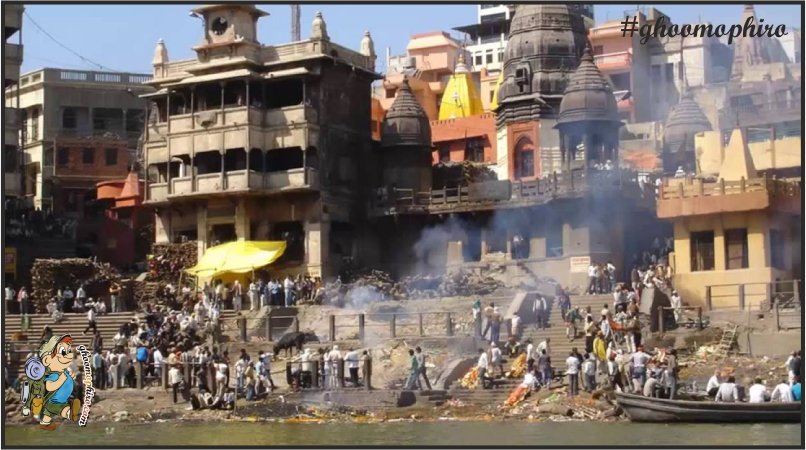Memories from Ghats in Varanasi
Posted on July 15, 2017 by Ghoomophiro

One of the best experiences that one has while travelling to the holy city of Varanasi is taking a boat ride across the ghats for which the city is famous. These ghats, which happen to be over 100 in Varanasi, are of great significance to the people of Varanasi and the Hindus in general.
There are a few of them though, which you should not miss at any cost if you happen to be in the city even for a very short period of time.
Assi Ghat- The Assi ghat is located right at the place where the Holy River Ganges meets the Assi River. It’s not as crowded or chaotic as the other ghats in the city and it being located at the southern corner of the series of ghats, it’s one of the most beautiful of them all.
Chet Singh Ghat- Other than the obvious, Chet Singh ghat is also known for one other thing. It was the place where Maharaja Chet Singh fought the British troops in the 18th century. There is very grand fort nearby, marking the defeat of the king.
Darbhanga Ghat- Darbhanga ghat is arguably the most impressive, beautiful and architecturally significant ghat in the city. It has a grand palace in its proximity which was built by the royal family of Bihar in the early 1900’s.
Dasaswamedh Ghat- This one is the ghat where the grand aarti takes place every other evening. It is one of the oldest and the biggest tourist attraction in the city. The chaotic vibe of the ghat is not irritating; it’s the extreme opposite, soothes the senses.
Man Mandir Ghat- The amazing Rajput architecture influence makes this ghat separate from the rest. This also happens to be one of the oldest ghats in the city and there is a grand palace right nearby it which is said to have been built by Raja Man Singh of Jaipur in 1600. An additional observatory got added later in the 19th century.
Scindia Ghat- Scindia ghat is picturesque and peaceful to its core with absolute distance from the chaos of the nearby Manikarna ghat, the ghat that burns. Other attraction besides the ghat itself is the submerged Shiva shrine which happens to be partially visible. The temple sunk underwater in 1830 due to some construction work that took place.
Bhosale Ghat- Bhosale ghat looks distinctively fresh and got built by the royal Maratha family of Nagpur. The artistic nature of the ghat makes it quite popular among the tourists as the windows at the top of the building are amazing to watch.
Manikarna Ghat- This is the ghat where most of the bodies get cremated in the entire city. Hindus hold a firm belief if the bodies were burnt here, it would make them free from the cycle of birth and death.
Do’s and Dont’s
Do’s
Do respect the rituals taking place at Cremation Ghats in Varanasi. The fact that they even allow tourists to watch such a personal affair in their lives is incredible but at the same time, you should respect the holy surroundings. Before entering, you should put your earphones in your backpack and avoid indulging into music at such places.
Dont’s
While planning to visit these cremation ghats, do not carry your camera and do not click photographs of cremations and rituals nearby, not even from the river, as it believed to interrupt the soul’s journey to Nirvana and also it is disrespectful to the family members in grief. Also, do not indulge in littering the holy sites.
One can see thousands of people bathing in the Ganges usually at sunrise at these ghats which is a beautiful sight to watch. Don’t miss on going for a boat ride (at early morning or after sunset) and explore the different sounds and tempting smell coming from the alleys.
For bookings to Varanasi, connect with us at ghoomophirosisters@gmail.com








varansi is a holy place and if a person wants to know about hindu religion than go ahead with that… there is so many ghat, temple and views. such a nice place to understand hindu religion.
Thank you Prachi for the information. do’s and don’t is very useful. respect the rituals become more connected to the place.
Hi
Visiting Varanasi has always been a dream. Hopefully some time soon
Thanks a lot for sharing this article. Its detailed and informative.
I read your all blogs and i enjoy it. Thanks you for this blog
Thanks. Happy Reading
Just loved your posts incredible India
Looks like a historical ghat. I heard it about it few years ago. Thanks for the memory you have shared.
🙂
holy place of India …. Incredible India….loved your posts
Great article about Varanasi, where the people of India believe the Moksha awaits. A sensitive place for Hindu people, mostly the elderly people. People also believe that this place will completely wash off their sins.